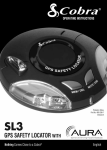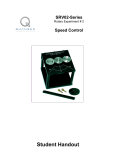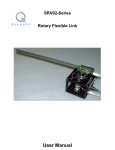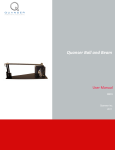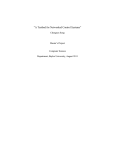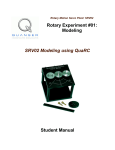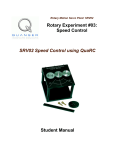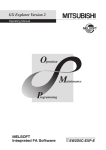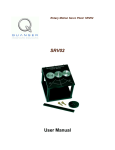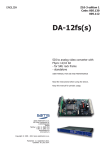Download Rotary Experiment #04: BB01 Control Ball and Beam Position
Transcript
Rotary Motion Servo Plant: SRV02 Rotary Experiment #04: BB01 Control Ball and Beam Position Control using QuaRC Student Manual SRV02 Ball and Beam Laboratory – Student Manual Table of Contents 1. INTRODUCTION..........................................................................................................................................1 2. PREREQUISITES.........................................................................................................................................1 3. OVERVIEW OF FILES..................................................................................................................................2 4. PRE-LAB ASSIGNMENTS.............................................................................................................................4 4.1. Modeling from First-Principles........................................................................................................4 4.1.1. Nonlinear Equation of Motion...............................................................................................................5 4.1.2. Adding SRV02 Dynamics......................................................................................................................8 4.1.3. Obtaining Transfer Function..................................................................................................................9 4.2. Desired Control Response..............................................................................................................11 4.2.1. Time-Domain Specifications................................................................................................................11 4.2.2. Settling Time .......................................................................................................................................11 4.2.3. Percentage Overshoot and Peak Time..................................................................................................13 4.2.4. Steady-state Error.................................................................................................................................13 4.3. Ball and Beam Cascade Control Design.........................................................................................14 4.3.1. Inner Loop Design: SRV02 PV Position Controller.............................................................................15 4.3.2. Outer Loop Stability Analysis..............................................................................................................17 4.3.3. Outer Loop Controller Design..............................................................................................................22 5. IN-LAB PROCEDURES...............................................................................................................................33 5.1. Position Control Simulation...........................................................................................................33 5.1.1. Outer-Loop Simulation........................................................................................................................33 5.1.2. Cascade Control Simulation.................................................................................................................40 5.2. Position Control Implementation....................................................................................................53 5.2.1. Setup for Position Control Implementation..........................................................................................54 5.2.2. Running the Practical PD Controller....................................................................................................54 Document Number 711 ♦ Revision 1.1 ♦ Page i SRV02 Ball and Beam Laboratory – Student Manual 5.2.3. Controlling using the Remote Sensor (Optional).................................................................................60 6. RESULTS SUMMARY.................................................................................................................................62 7. REFERENCES...........................................................................................................................................63 Document Number 711 ♦ Revision 1.1 ♦ Page ii SRV02 Ball and Beam Control Laboratory – Student Manual 1. Introduction The objective of the Ball and Beam experiment is to stabilize the ball to a desired position along the beam. Using the proportional-derivative (PD) family, a cascade control system is designed to meet a set of specifications. The following topics are covered in this laboratory: ● Model the dynamics of the ball from first-principles. ● Obtain a transfer function representation of the system. ● Design a proportional-velocity (PV) compensator to control the position of the servo load shaft according to certain time-domain requirements. ● Using root locus, assess whether or not the specifications can be met with a certain type of compensator. ● Design a compensator that regulates the position of the ball on the beam and meets certain specifications. This together with the servo control is the complete Ball and Beam cascade control system. ● Simulate the Ball and Beam control using the model of the plant and ensure the specifications are met without any actuator saturation. ● Implement the controllers on the Quanser BB01 device and evaluate its performance. 2. Prerequisites In order to successfully carry out this laboratory, the user should be familiar with the following: ● Data acquisition card (e.g. Q8), the power amplifier (e.g. UPM), and the main components of the SRV02 (e.g. actuator, sensors), as described in References [1], [4], and [5], respectively. ● Wiring and operating procedure of the SRV02 plant with the UPM and DAC device, as discussed in Reference [5]. ● Laboratory described in Reference [6] in order to be familiar using QuaRC with the SRV02. ● Designing a PV position control for the SRV02 as dictated in Reference [8]. Document Number 711 ♦ Revision 1.1 ♦ Page 1 SRV02 Ball and Beam Control Laboratory – Student Manual 3. Overview of Files Table 1 below lists and describes the various files supplied with the SRV02 Ball and Beam Position Control laboratory. File Name Description 09 – Ball and Beam User Manual.pdf This manual describes the hardware of the Ball and Beam and explains how to setup and wire the system for the experiments. 10 – Ball and Beam Position Control – Student Manual.pdf This laboratory guide contains pre-lab and in-lab exercises demonstrating how to design and implement a position controller on the Quanser SRV02 Ball and Beam plant using QuaRC. setup_srv02_exp04_bb01.m The main Matlab script that sets the SRV02 motor and sensor parameters, the SRV02 configuration-dependent model parameters, and the BB01 sensor parameters. Run this file only to setup the laboratory. config_srv02.m Returns the configuration-based SRV02 model specifications Rm, kt, km, Kg, eta_g, Beq, Jeq, and eta_m, the sensor calibration constants K_POT, K_ENC, and K_TACH, and the UPM limits VMAX_UPM and IMAX_UPM. config_bb01.m Returns the configuration-based BB01 model specifications L_beam, r_arm, r_b, m_b, J_b, and g, the servo offset THETA_OFF, the min/max servo limits THETA_MIN and THETA_MAX, and the sensor calibration constant K_BS. d_model_param.m Calculates the SRV02 model parameters K and tau based on the device specifications Rm, kt, km, Kg, eta_g, Beq, Jeq, and eta_m. calc_conversion_constants.m Returns various conversions factors. s_bb01_pos_outer_loop.mdl Simulink file that simulates the closed-loop system when using only the outer-loop ball position controller with the BB01 system, i.e. no inner loop control of the servo position. s_bb01_pos.mdl Simulink file that simulates the cascade ball position controller. Both the outer-loop ball position control and the inner-loop servo position control are used in this file. q_bb01_pos.mdl Simulink file that implements a closed-loop cascade position controller on the actual BB01 system using QuaRC. Document Number 711 ♦ Revision 1.1 ♦ Page 2 SRV02 Ball and Beam Control Laboratory – Student Manual File Name Description Document Number 711 ♦ Revision 1.1 ♦ Page 3 SRV02 Ball and Beam Control Laboratory – Student Manual File Name Description Table 1: Files supplied with the SRV02 Ball and Beam Position Control experiment. 4. Pre-Lab Assignments 4.1. Modeling from First-Principles As illustrated in Figure 1, this system is comprised of two plants: the SRV02 and the BB01. Figure 1: Ball and Beam open-loop block diagram. The main objective in this section is to obtain the complete SRV02+BB01 transfer function P( s ) = Pbb( s ) Ps( s ) [1] where the BB01 transfer function is X( s ) Pbb( s ) = [2] Θ l( s ) and the SRV02 transfer function is Θ l( s ) Ps( s ) = [3] Vm ( s ) . Document Number 711 ♦ Revision 1.1 ♦ Page 4 SRV02 Ball and Beam Control Laboratory – Student Manual The BB01 transfer function describes the displacement of the ball with respect to the load angle of the servo. In the next few sections, the time-based motion equations are developed and, from these equations of motion, its transfer function is obtained. Recall in Reference [7], that the SRV02 voltageto-load angle plant transfer function was found to be K Ps( s ) = [4] (τ s + 1) s . This can be added to the system to get the full SRV02+BB01 model. 4.1.1. Nonlinear Equation of Motion In this section, the equation describing the motions of the ball, x, relative to the angle of the beam, α, is derived. Thus the equation of motion, or eom for short, will be of the form 2 d x( t ) = f( α ( t ) ) [5] 2 dt , where f(α(t)) is a nonlinear function. The incomplete free-body diagram of the ball on a beam is illustrated in Figure 2. Applying Newton's Law of Motion, the sum of the forces acting on the ball alongside the beam equals 2 d mb x( t ) = F [6] 2 dt , where mb is the mass of the ball. ∑ Figure 2: Free-body diagram of Ball and Beam. Document Number 711 ♦ Revision 1.1 ♦ Page 5 SRV02 Ball and Beam Control Laboratory – Student Manual Neglecting friction and viscous damping, the ball forces can can be represented by 2 d mb x( t ) = Fx , t − Fx , r [7] 2 dt , where Fr is the force from the ball's inertia and Ft is the translational force generated by gravity. For the ball to be stationary at a certain moment, i.e. be in equilibrium, the force from the ball's momentum must be equivalent to the force produced by gravity. 1. Find the force in the x direction (along the beam) that is caused by gravity, Fx,t. 0 1 2 2. Find the force that is caused by rotational inertia of the ball in the x direction, Fx,r. Hint: Use the sector formula to convert between linear and angular displacement (e.g. or velocity and acceleration) x( t ) = γ b( t ) rb [8] where γb is the angle of the ball and rb is the ball radius. Document Number 711 ♦ Revision 1.1 ♦ Page 6 SRV02 Ball and Beam Control Laboratory – Student Manual 0 1 2 3. Give the nonlinear equation of motion of the ball and beam. It should be in the form shown in [5]. 0 1 2 4.1.2. Adding SRV02 Dynamics In this section the equation of motion representing the position of the ball relative the angle of the Document Number 711 ♦ Revision 1.1 ♦ Page 7 SRV02 Ball and Beam Control Laboratory – Student Manual SRV02 load gear is found. The obtained equation is nonlinear (includes a trigonometric term) and it will have to be linearized in order for the model to be used for control design. 1. Using the schematic given in Reference [9], find the relationship between the SRV02 load gear angle, θl, and the beam angle, α. 0 1 2 2. Find the equation of motion that represent the ball's motion with respect to the SRV02 angle θl. Linearize the equation of motion about servo angle θl(t) = 0 0 1 2 3. Simplify the expression by lumping the coefficient parameters of θl(t) into parameter Kbb. This is the model gain of the Ball and Beam system. Show the new simplified equation of motion. Document Number 711 ♦ Revision 1.1 ♦ Page 8 SRV02 Ball and Beam Control Laboratory – Student Manual Then, evaluate the model gain numerically using the Ball and Beam parameters given in Reference [9]. Hint: Recall that the moment of inertia of a solid sphere is 2 2mr [9] J= 5 where m is the mass of the ball and r is its radius. 0 1 2 4.1.3. Obtaining Transfer Function In this section the transfer function describing the servo voltage to ball position displacement is found. 1. Find the transfer function Pbb(s) of the BB01. Assume all initial conditions are zero. Document Number 711 ♦ Revision 1.1 ♦ Page 9 SRV02 Ball and Beam Control Laboratory – Student Manual 0 1 2 2. Give the complete SRV02+BB01 process transfer function P(s). 0 1 2 Document Number 711 ♦ Revision 1.1 ♦ Page 10 SRV02 Ball and Beam Control Laboratory – Student Manual 4.2. Desired Control Response 4.2.1. Time-Domain Specifications The time-domain specifications for controlling the position of the SRV02 load shaft are: ess = 0 [10] , t p = 0.15 [ s ] [11] , and PO = 5.0 [ "%"] . [12] Thus when tracking the load shaft step reference, the transient response should have a peak time less than or equal to 0.15 seconds, an overshoot less than or equal to 5 %, and no steady-state error. The specifications for controlling the position of the ball are: ess ≤ 0.005 [ m ] , t s = 3.5 [ s ] cts = 0.04 , and PO = 10.0 [ "%"] . [13] [14] [15] [16] Given a step reference, the peak position of the ball should not overshoot over 10%. After 3.5 seconds, the ball should settled within 4% of its steady-state value (i.e. not the reference) and the steady-state should be within 5 mm of the desired position. 4.2.2. Settling Time The response of a second-order system, y(t), when subjected to a unit step reference, r(t), is shown in Figure 3. This response has a 5% settling time of 0.30 seconds. Thus the response settles within 5% of its steady-state value, which is between 0.95 and 1.05, in 0.30 seconds. Settling time is defined ts = t1 − t0 [17] where the initial step time is t0 and the time it takes to settle is t1. Document Number 711 ♦ Revision 1.1 ♦ Page 11 SRV02 Ball and Beam Control Laboratory – Student Manual Figure 3: Settling time of unit step response. An equation that expresses the settling time in terms of the natural frequency, ωn, and the damping of a second-order system, ζ, is required. In order to find this, an exponentially decreasing sinusoidal is used to approximate the upper-bound of the response and is expressed ( − ζ ω n ts ) e [18] yub = 1 + 2 1− ζ . 1. Given the settling time percentage equation cts = yub − 1 [19] and the upper-bound formula, show that the settling time equation is 2 ln( cts 1 − ζ ) ts = − ζ ωn . [20] Document Number 711 ♦ Revision 1.1 ♦ Page 12 SRV02 Ball and Beam Control Laboratory – Student Manual 0 1 2 4.2.3. Percentage Overshoot and Peak Time Recall from Reference [8] that the peak time and percentage overshoot equations are π tp = [21] 2 ωn 1− ζ and PO = 100 e − π ζ 2 1− ζ [22] . 4.2.4. Steady-state Error In this section, the steady-state error of the ball position is evaluated using a proportional compensator. Recall the unity feedback system in Figure 4. Figure 4: Unity feedback system. Document Number 711 ♦ Revision 1.1 ♦ Page 13 SRV02 Ball and Beam Control Laboratory – Student Manual 1. Find the steady-state error the ball and beam, Pbb(s), with a unity compensator C( s ) = 1 [23] and a reference step of R0 [24] R( s ) = s , where R0 is the step amplitude. Remark that in this calculation the SRV02 dynamics are ignored and only the BB01 plant is being considered. If there is no constant steady-state error, then describe the error of the system. 0 1 2 4.3. Ball and Beam Cascade Control Design The cascade control that will used for the SRV02+BB01 system is illustrated by the block diagram given in Figure 5. Based on the measured ball position X(s), the ball and beam compensator, Cbb(s), in the outer-loop computes the servo load angle needed, Θd(s), to attain the desired ball position, Xd(s). The inner loop is a servo position control system as described in Reference [8]. Thus the servo compensator Cs(s) calculates the motor voltage required for the load angle to track the given desired load angle. Document Number 711 ♦ Revision 1.1 ♦ Page 14 SRV02 Ball and Beam Control Laboratory – Student Manual Figure 5: Cascade control system used to control ball position in SRV02+BB01 plant. In Section 4.3.1, the position controller for the SRV02 is designed, similarly as explained in Reference [8]. A compensator is introduced in Section 4.3.2 and it is assessed using root locus whether it can be used to meet the desired specifications. Two different variations of a compensator are designed in Section 4.3.3. 4.3.1. Inner Loop Design: SRV02 PV Position Controller In this section, the proportional-velocity (PV) controller gains are computed for the SRV02 when it is in the high-gear configuration and based on the specifications given in Section 4.2.1. The internal control loop is depicted in the block diagram shown in Figure 6. Figure 6: SRV02 closed-loop system. 1. The nominal model parameters, K and τ, when the SRV02 is in high-gear configuration are Document Number 711 ♦ Revision 1.1 ♦ Page 15 SRV02 Ball and Beam Control Laboratory – Student Manual rad K = 1.76 sV and τ = 0.0285 [ s ] . [25] [26] Given these parameters, calculate the minimum damping ratio and natural frequency required to meet the SRV02 specifications given in Section 4.2.1. 0 1 2 2. Using the derivations in Experiment #2: SRV02 Position Control (Reference[8]), calculate the control gains needed to satisfy the time-domain response requirements. 0 1 2 Document Number 711 ♦ Revision 1.1 ♦ Page 16 SRV02 Ball and Beam Control Laboratory – Student Manual 4.3.2. Outer Loop Stability Analysis The inner loop that controls the position of the SRV02 load shaft is complete and it the servo dynamics are now considered negligible. Thus it is assumed that the desired load angle equals the actual load angle θ l( t ) = θ d( t ) [27] . The outer-loop shown in Figure 7 will be used to control the position of the ball on the beam. Figure 7: BB01 closed-loop system. 4.3.2.1. Root Locus of Open-Loop System The root locus shows how the poles of a closed-loop system move when a proportional gain increases towards infinity. 1. Using Figure 7, find the closed-loop transfer function of the BB01 system with the proportional control Cbb( s ) = Kc [28] . Document Number 711 ♦ Revision 1.1 ♦ Page 17 SRV02 Ball and Beam Control Laboratory – Student Manual 0 1 2 2. Plot the root locus of the BB01 plant Pbb(s). The closed-loop transfer function found above can help describe how the poles behave as Kc goes to infinity. Document Number 711 ♦ Revision 1.1 ♦ Page 18 SRV02 Ball and Beam Control Laboratory – Student Manual 0 1 2 4.3.2.2. Desired Location of Poles Consider the prototype second-order system ω n2 Y( s ) = R( s ) 2 s + 2 ζ ω n s + ω n2 [29] . The location of the two poles of this system when the natural frequency is Document Number 711 ♦ Revision 1.1 ♦ Page 19 SRV02 Ball and Beam Control Laboratory – Student Manual rad ω n = 1.5 s and the damping ratio is ζ = 0.6 is illustrated in Figure 8. [30] [31] Figure 8: Desired pole locations. As illustrated, the natural frequency determines the radial length of the poles from the origin. The damping ratio changes the angle where they are positioned from the imaginary axis according to the relationship θ = arcsin( ζ ) . [32] The location of the poles along the imaginary axis is called the damped natural frequency 2 [33] ωd= ωn 1− ζ , and the position of the poles along the real-axis is described by the equation σ = ζ ωn [34] . Document Number 711 ♦ Revision 1.1 ♦ Page 20 SRV02 Ball and Beam Control Laboratory – Student Manual 1. Find the natural frequency and damping ratio required to achieve the time-domain specifications of the Ball and Beam plant given in Section 4.2.1. 0 1 2 2. Similarly as shown in Figure 8, plot the region where the poles should lie to satisfy the specifications. 0 1 2 3. Discuss the response if the poles lie beyond the radius circle along the diagonal lines, i.e. away from the imaginary axis. Also, comment on what happens if the poles of the system lie inside the diagonal lines along the radius circle, i.e. moving towards the real axis. Make references to its effects on the settling time and overshoot of the response. Document Number 711 ♦ Revision 1.1 ♦ Page 21 SRV02 Ball and Beam Control Laboratory – Student Manual 0 1 2 4. Based on the root locus obtained previously, can the specifications of the Ball and Beam system be satisfied using a proportional controller? Discuss. 0 1 2 4.3.3. Outer Loop Controller Design So far the analysis has been done using a proportional compensator. Now the affects using a dynamic compensator in the loop path of Figure 7 is studied. Generally speaking, adding a zero in the forwardpath increases the bandwidth of the closed-loop system. Adding a pole increases the rise time and overshoot of the system but makes it overall less stable. In our case, the bandwidth must be increased and the overshoot has to be minimized. The effects of adding a zero in the forward loop path are studied Section 4.3.3.1 and the obtained steady-state error is assessed in Section 4.3.3.2. The first controller to be designed is a proportionalderivative (PD) compensator. This is done in Section 4.3.3.3. This design is then modified in Section Document Number 711 ♦ Revision 1.1 ♦ Page 22 SRV02 Ball and Beam Control Laboratory – Student Manual 4.3.3.4 to handle some inherent practical issues. 4.3.3.1. PD Compensator Analysis Consider the following PD compensator Cbb( s ) = Kc ( s + z ) , where Kc is the proportional gain and z is the location of the compensator zero. [35] 1. Plot the root locus of the BB01 loop transfer function Lbb( s ) = Cbb( s ) Pbb( s ) [36] when the compensator zero is placed somewhere between 0.2 and 0.5 along the negative real axis. 0 1 2 Document Number 711 ♦ Revision 1.1 ♦ Page 23 SRV02 Ball and Beam Control Laboratory – Student Manual 2. Could this compensator be used to satisfy the ball and beam settling time and overshoot specifications? Explain with references to the location of the zero and the gain. 0 1 2 3. Find the closed-loop transfer function of the ball and beam, X(s)/Xd(s), when using the proportional-velocity (PV) controller shown in Figure 9. This is a variation of the PD compensator that does not feed the setpoint velocity, sXd(s), and is similar to what is used to control the position of the SRV02. Figure 9: Ball and beam ideal PV controller. Document Number 711 ♦ Revision 1.1 ♦ Page 24 SRV02 Ball and Beam Control Laboratory – Student Manual 0 1 2 4.3.3.2. Steady-State Error In this section, it is assessed whether the steady-state error specification, given in [13], can be met using the PD controller in [35]. 1. Find the BB01 error transfer function when using PD compensator [35]. Can the final-value theorem be used on this system? 0 1 2 Document Number 711 ♦ Revision 1.1 ♦ Page 25 SRV02 Ball and Beam Control Laboratory – Student Manual 2. Find the steady-state error of the BB01 closed-loop system with the PD controller. Can the steady-state error requirement in [13] be satisfied using a PD compensator? 0 1 2 4.3.3.3. Ideal PD Control Design The proportional and velocity gains needed to meet the desired requirements in Section 4.2.1 are found in this section. This is called the ideal PD controller. 1. Where should the zero lie and the gain be to meet the settling time and overshoot specifications? Find expressions for the zero location, z, and the compensator gain, Kc, that will satisfy a given natural frequency and damping ratio. Document Number 711 ♦ Revision 1.1 ♦ Page 26 SRV02 Ball and Beam Control Laboratory – Student Manual 0 1 2 2. Based on the expressions found, evaluate numerically the zero location and gain needed to satisfy the specifications. 0 1 2 4.3.3.4. Practical PD Controller The designed ideal PD controller cannot be used to control the ball position on the actual BB01 device because it takes a direct derivative to obtain the ball velocity. The position of the ball is measured using an analog sensor and it has some inherent noise. Taking the derivative of this type of signal would Document Number 711 ♦ Revision 1.1 ♦ Page 27 SRV02 Ball and Beam Control Laboratory – Student Manual output results in an amplified high-frequency signal that is eventually fed back into the motor and causes a grinding noise. As illustrated by H(s) in Figure 10, this is prevented by using a high-pass filter. The first-order filter replaces the derivative in Figure 10 and has the form ωfs H( s ) = [37] s+ ωf . For adequate filtering of the noise found in the BB01 linear transducer, the cutoff frequency will be set to 1 Hz, or rad ω f = 6.28 [38] s . Also added to the controller is the set-point weight parameter bsp. This varies the amount of setpoint that is used to compute the error velocity. This compensator is called the practical PD controller. Figure 10: BB01 PD controller with filtering. Although filtering is often necessary when controlling actual systems to make it more robust against noise, it does add dynamics to the system. Thus the compensator gain and zero location have to be recomputed in order to meet the specifications listed in Section 4.2.1. 1. Using the block diagram in Figure 10, find the closed-loop equation of the BB01 (only the outer-loop, no servo dynamics). Document Number 711 ♦ Revision 1.1 ♦ Page 28 SRV02 Ball and Beam Control Laboratory – Student Manual 0 1 2 2. Find the BB01 compensator, Cpp(s) in Figure 7, when the set-point weight of the practical PD controller is 1, i.e. bsp = 1. 0 1 2 3. Find the locations of the zero and the pole of the compensator. What type of compensator does the PD becomes when adding filtering (e.g. lead or lag)? Document Number 711 ♦ Revision 1.1 ♦ Page 29 SRV02 Ball and Beam Control Laboratory – Student Manual 0 1 2 4. The third-order characteristic equation is 2 [38] ( s + 2 ζ ω n s + ω n 2 ) ( 1 + Tp s ) where Tp is the pole decay in seconds. Where should the zero and pole lie and the gain be to meet the settling time and overshoot specifications? First, find an expressions for the pole location, Tp, that will satisfy the natural frequency and damping ratio requirements in Section 4.2.1 as well as the desired filter cutoff frequency given in [38]. Document Number 711 ♦ Revision 1.1 ♦ Page 30 SRV02 Ball and Beam Control Laboratory – Student Manual 0 1 2 5. Find expressions for the zero location, z, and the compensator gain, Kc, that will satisfy ωn and ζ in Section 4.2.1 and the desired filter cutoff frequency in [38]. Document Number 711 ♦ Revision 1.1 ♦ Page 31 SRV02 Ball and Beam Control Laboratory – Student Manual 0 1 2 6. Based on the expressions found, evaluate numerically the pole time constant, zero location, and gain needed to satisfy the specifications. 0 1 2 Document Number 711 ♦ Revision 1.1 ♦ Page 32 SRV02 Ball and Beam Control Laboratory – Student Manual 5. In-Lab Procedures The closed-loop response of the Ball and Beam is simulated in Section 5.1 and then implement on the actual BB01 device in Section 5.2. 5.1. Position Control Simulation Go through Section 5.1.1 to simulate the Ball and Beam system using the designed compensator and ensure it meets the specifications listed in Section 4.2.1. This section deals with only the outer-loop control. In Section 5.1.2, the ball and beam is simulated using its full cascade control system. That is, the system that includes both the outer ball position control loop and the inner servo position control feedback loop. 5.1.1. Outer-Loop Simulation The s_bb01_pos_outer_loop Simulink diagram shown in Figure 11 is used to simulate the closed-loop position response of the BB01 when using the outer-loop control. Thus the SRV02 dynamics are neglected, i.e. θd = θl. The response is simulated using the developed nonlinear model of the Ball and Beam. Document Number 711 ♦ Revision 1.1 ♦ Page 33 SRV02 Ball and Beam Control Laboratory – Student Manual Figure 11: Simulink diagram used to simulated the outer closed-loop BB01 system. The BB01 Nonlinear Model subsystem includes the Pbb(s) transfer function that was derived in Section 4.1.3. Recall in Section 4.1.2 that the model had to be linearized in order to obtain the Pbb(s) transfer function. This nonlinearity is re-introduced in the BB01 Nonlinear Model subsystem in order to represent the plant more accurately and ensure the specifications can still be satisfied. The BB01 PD Position Control subsystem contains the ideal PD compensator designed in Section 4.3.3.3. Remark that it includes a Saturation block that limits the SRV02 angle between ±56 degrees. Go through the steps in Section 5.1.1.1 to setup the Matlab workspace. The procedure to simulate the closed-loop Ball and Beam outer-loop response with the ideal PD compensator is detailed in Section 5.1.1.2. 5.1.1.1. Setup for Position Control Simulation Follow these steps to configure the lab properly: 1. Load the Matlab software. 2. Browse through the Current Directory window in Matlab and find the folder that contains the BB01 controller files. 3. Double-click on the s_bb01_pos_outer_loop.mdl file to open the Simulink diagram shown in Figure 11. 4. Double-click on the setup_srv02_exp04_bb01.m file to open the setup script for the BB01 Simulink models. Document Number 711 ♦ Revision 1.1 ♦ Page 34 SRV02 Ball and Beam Control Laboratory – Student Manual 5. Configure setup script: When used with the Ball and Beam, the SRV02 must be in the highgear configuration and no load is to be specified. Make sure the script is setup to match this configuration, i.e. the EXT_GEAR_CONFIG should be set to 'HIGH' and the LOAD_TYPE should be set to 'NONE'. Also, ensure the ENCODER_TYPE, TACH_OPTION, K_CABLE, UPM_TYPE, and VMAX_DAC parameters are set according to the SRV02 system that is to be used in the laboratory. Next, set CONTROL_TYPE to 'MANUAL'. 6. Run the script by selecting the Debug | Run item from the menu bar or clicking on the Run button in the tool bar. The messages shown in Text 1, below, should be generated in the Matlab Command Window. The model parameters and specifications are loaded but the SRV02 PV gains and compensator gain are all set to zero and the compensator pole and zero are set to 1 – they need to be changed. SRV02 model parameters: K = 0 rad/s/V tau = 0 s SRV02 Specifications: tp = 0.15 s PO = 5 % BB01 model parameter: K_bb = 0 m/s^2/rad BB01 Specifications: ts = 3.5 s PO = 10 % Calculated SRV02 PV control gains: kp = 0 V/rad kv = 0 V.s/rad Natural frequency and damping ratio: wn = 0 rad/s zeta = 0 BB01 PD compensator: Kc = 0 rad/m z = 1 rad/s wf = 6.28 rad/s Text 1: Display message shown in Matlab Command Window after running setup_srv02_exp04_bb01.m. Document Number 711 ♦ Revision 1.1 ♦ Page 35 SRV02 Ball and Beam Control Laboratory – Student Manual 5.1.1.2. Outer-Loop Ideal PD Simulation In this section, the root locus of the forward path is plotted using Matlab and the closed-loop step position response of the BB01 will be simulated to verify that the specifications are met. As previously mentioned, the simulation is performed using the nonlinear model of the Ball and Beam and the ideal PD controller that was designed. Follow these steps to simulate the nonlinear BB01 position response: 1. Enter the BB01 model gain found in Section 4.1.2 in Matlab as variable Kbb. 2. Enter the BB01 compensator gain Kc, and the compensator zero, z, that were found in Section 4.3.3.3. 3. Using Matlab, plot the root locus of BB01 loop transfer function when using the ideal PD controller and attach it to your report. Similarly as in Figure 8, use the sgrid command to include the dashed lines that show the desired locations of the poles. Ensure the poles go through the desired locations at the gain that was computed. Document Number 711 ♦ Revision 1.1 ♦ Page 36 SRV02 Ball and Beam Control Laboratory – Student Manual 0 1 2 4. Select square in the Signal Type field of the SRV02 Signal Generator in order to generate a step reference 5. Set the Amplitude (cm) slider gain block to 5 to generate a step with an amplitude of 5.0 centimeters 6. Open the load shaft position scope, theta_l (deg), and the ball position scope, x (m). 7. Start the simulation. By default, the simulation runs for 25.0 seconds. The scopes should be displaying responses similar to figures 12 and 13. In the x (m) scope, the yellow trace is the desired ball position and the purple trace is the simulated response. Document Number 711 ♦ Revision 1.1 ♦ Page 37 SRV02 Ball and Beam Control Laboratory – Student Manual Figure 12: Outer-loop ideal PD ball position response. Figure 13: Outer-loop ideal PD servo angle response. 8. Generate a Matlab figure showing the nonlinear Outer-Loop BB01 ball position response and the corresponding servo angle and attach it to your report. After each simulation run, each scope automatically saves their response to a variable in the Matlab workspace. The x (m) scope saves its response to the variable called data_x and the theta_l (deg) scope saves its response to the variable data_theta_l. The data_x variable has the following structure: data_x(:,1) is the time vector, data_x(:,2) is the setpoint, and data_x(:,3) is the simulated ball position. For the data_theta_l variable, data_theta_l (:,1) is the time and data_theta_l (:,2) is the servo angle. Document Number 711 ♦ Revision 1.1 ♦ Page 38 SRV02 Ball and Beam Control Laboratory – Student Manual 0 1 2 9. Measure the steady-state error, the settling time, and the percentage overshoot of the simulated response. Document Number 711 ♦ Revision 1.1 ♦ Page 39 SRV02 Ball and Beam Control Laboratory – Student Manual 0 1 2 10. Does the outer-loop ideal PD response satisfy the specifications given in Section 4.2.1 while keeping the servo angle between ±56 degrees? Some tolerance is allowed on the settling time specification: it should not exceed 3.75 seconds (rather then 3.50 seconds). If the steady-state error and percentage overshoot do no meet the desired specifications and the settling time goes over 3.75 seconds then go back to your control design. If the settling time does not satisfy the original specifications but is kept below the allowed tolerance, explain any possible source for this discrepancy? 0 1 2 Document Number 711 ♦ Revision 1.1 ♦ Page 40 SRV02 Ball and Beam Control Laboratory – Student Manual 5.1.2. Cascade Control Simulation The servo dynamics can now be added and the closed-loop position response when using the cascade control system will be simulated using the Simulink diagram pictured in Figure 14. This Simulink model simulates the block diagram shown in Figure 5. Figure 14: Simulink diagram used to simulate cascade control system. The SRV02+BB01 Model subsystem includes the nonlinear model of the BB01 plant and the transfer function representing the SRV02 voltage-to-position relationship. The proportional-velocity position controller designed in Section 4.3.1 is implemented in the SRV02 PV Position Control block. The cascade controller is the algorithm that will be implemented on the actual SRV02+BB01 device. Before deployment, we need to confirm that the specifications are still satisfied when the servo dynamics are added. In addition, the servo angle must be kept between ±56 degrees and the servo voltage cannot exceed ±10 V. 5.1.2.1. Ideal PD Cascade Simulation The purpose of this simulation is to see how the settling time, overshoot, and steady-state error of the response changes when adding the inner-loop servo control that was designed in Section 4.3.1. Follow these steps to simulate the ideal PD closed-loop SRV02+BB01 cascade control response: 1. Follow steps 1 and 2 in Section 5.1.1.2 the to setup the Matlab workspace. Document Number 711 ♦ Revision 1.1 ♦ Page 41 SRV02 Ball and Beam Control Laboratory – Student Manual 2. Enter the low-gear SRV02 model gain, K, and the model time constant, tau, in Matlab found in Section 4.3.1. 3. Enter the SRV02 PV gains: called variables kp and kv in Matlab found in Section 4.3.1. 4. Select square in the Signal Type field of the SRV02 Signal Generator in order to generate a step reference. 5. Set the Amplitude (cm) slider gain block to 5 to generate a step with an amplitude of 5.0 centimeters. 6. Open the ball position scope x (m), the load shaft position scope theta_l (deg), and the SRV02 motor input voltage scope Vm(V). 7. Place the Manual Switch in the BB01 PD Position Control subsystem to the upward position in order to use the ideal PD controller when simulating. 8. Start the simulation. By default, the simulation runs for 25.0 seconds. The scopes should be displaying responses similar to figures 15, 16, and 17. The yellow and purples plots in the x (m) scope is the ball position setpoint and the its simulated response. Similarly in the theta_l (deg) scope, the yellow trace is the desired servo angle position, which is generated by the outer-loop control, and the the purple plot is the simulated servo response. Figure 15: Ideal PD cascade control ball position response. Figure 16: Ideal PD cascade control servo angle response. Document Number 711 ♦ Revision 1.1 ♦ Page 42 SRV02 Ball and Beam Control Laboratory – Student Manual Figure 17: Ideal PD cascade input voltage. 9. Generate a Matlab figure showing the Ideal PD cascade ball position, servo angle, and servo input voltage response and attach it to your report. As explained in the procedure of Section 5.1.1.2, the response from each scope is saved to a Matlab variable after each simulation run. The SRV02 motor input voltage is saved in the data_vm variable (data_vm (:,1) is the time and data_vm (:,2) is the voltage). Document Number 711 ♦ Revision 1.1 ♦ Page 43 SRV02 Ball and Beam Control Laboratory – Student Manual 0 1 2 10. Measure the steady-state error, the settling time, and the percentage overshoot of the ideal PD cascade control response. Document Number 711 ♦ Revision 1.1 ♦ Page 44 SRV02 Ball and Beam Control Laboratory – Student Manual 0 1 2 11. Are the specifications in Section 4.2.1 still satisfied after adding the servo dynamics? Also, make sure the servo angle is within ±56.0 degrees and the servo voltage is between ±10.0 V. Don't go back in the control design if some specifications are not met. 0 1 2 Document Number 711 ♦ Revision 1.1 ♦ Page 45 SRV02 Ball and Beam Control Laboratory – Student Manual 5.1.2.2. Practical PD Cascade Simulation The practical PD controller developed in Section 4.3.3.4 is simulated in this section. This is the compensator that will be used to control the actual BB01 device. The control gain and zero may have to be fine-tuned in order to compensate for the added dynamics of the filtering and the inner-loop servo control. Follow these steps to simulate the closed-loop practical cascade PD response: 1. Enter the BB01 model gain found in Section 4.1.2 in Matlab as variable Kbb. 2. Enter the practical PD compensator gain Kc, and zero, z, that were found in Section 4.3.3.4. The filter cutoff filter, wf, is already set by the script. 3. Follow steps 2-6 in Section 5.1.2.1 to setup the SRV02 model parameters and control gains and setup the Simulink diagram. 4. To simulate using the practical PD controller, set the Manual Switch in the BB01 PD Position Control subsystem to the downward position. 5. Using Matlab, plot the root locus of BB01 loop transfer function when using the practical PD compensator and attach it to your report. As in Figure 8, show the desired locations of the poles on the plots and ensure the poles go through the desired locations at the gain that was computed. Document Number 711 ♦ Revision 1.1 ♦ Page 46 SRV02 Ball and Beam Control Laboratory – Student Manual 0 1 2 6. Open the ball position scope x (m), the load shaft position scope theta_l (deg), and the SRV02 motor input voltage scope Vm(V). 7. Start the simulation. By default, the simulation runs for 25.0 seconds. The scopes should be displaying responses similar to figures 18, 19, and 20. Document Number 711 ♦ Revision 1.1 ♦ Page 47 SRV02 Ball and Beam Control Laboratory – Student Manual Figure 18: Practical cascade control ball position response. Figure 19: Practical cascade control servo angle response. Figure 20: Practical cascade control input voltage. 8. Generate a Matlab figure showing the practical cascade ball position, servo angle, and servo input voltage response and attach it to your report. Document Number 711 ♦ Revision 1.1 ♦ Page 48 SRV02 Ball and Beam Control Laboratory – Student Manual 0 1 2 9. Measure the steady-state error, the settling time, and the percentage overshoot of the simulated practical cascade PD control response. Document Number 711 ♦ Revision 1.1 ♦ Page 49 SRV02 Ball and Beam Control Laboratory – Student Manual 0 1 2 10. Does the simulated response satisfy the specifications given in Section 4.2.1 while keeping the servo angle between ±56.0 degrees and the servo voltage between ±10.0 V? 0 1 2 11. If a specification is not satisfied, then the control parameters need to be fine-tuned. One method is to redesign the compensator gain, zero location, and pole time constant, according to more stringent restrictions. For instance, try simulating the system for a Kc, z, and Tp, generated according to a percentage overshoot of 8% instead of 10%. To do this, write a short Matlab Document Number 711 ♦ Revision 1.1 ♦ Page 50 SRV02 Ball and Beam Control Laboratory – Student Manual script that computes the gains automatically according to a given set of percentage overshoot, settling time, and filter cutoff frequency specifications. Then simulate the system and see if the specifications are satisfied. Note that the cutoff filter frequency should remain as specified in Equation [38], or 1 Hz. Attach the script to you report. 0 1 2 12. Record the gain and zero have been fine-tuned for the response to meet the specifications along with the new specifications used to generate those control parameters. These control parameters will be called the Tuned Practical PD #1. Document Number 711 ♦ Revision 1.1 ♦ Page 51 SRV02 Ball and Beam Control Laboratory – Student Manual 0 1 2 13. Plot the simulated response in a Matlab figure and attach it your report. Document Number 711 ♦ Revision 1.1 ♦ Page 52 SRV02 Ball and Beam Control Laboratory – Student Manual 0 1 2 14. Give the resulting steady-state error, settling time, and percentage overshoot of the response. Document Number 711 ♦ Revision 1.1 ♦ Page 53 SRV02 Ball and Beam Control Laboratory – Student Manual 0 1 2 5.2. Position Control Implementation The q_bb01_pos Simulink diagram shown in Figure 21 is used to perform the position control exercises in this laboratory. The SRV02-ET+BB01 subsystem contains QuaRC blocks that interface with the DC motor and sensors of the Ball and Beam system. The BB01 PD Position Control subsystem implements the practical PD control detailed in Section 4.3.3.4. Figure 21: Simulink model used with QuaRC to run the practical PD controller on the Ball and Beam system. Document Number 711 ♦ Revision 1.1 ♦ Page 54 SRV02 Ball and Beam Control Laboratory – Student Manual Go through the steps in Section 5.2.1 to setup the Matlab workspace. The procedure to run the developed practical PD controller is outlined in Section 5.2.2. Section 5.2.3 shows how to run the same controller using the remote sensor module, i.e. SS01. 5.2.1. Setup for Position Control Implementation Before beginning the in-lab exercises on the Ball and Beam device, the q_bb01_pos Simulink diagram and the setup_srv02_exp04_bb01.m script must be configured. Follow these steps to get the system ready for this lab: 1. Setup the SRV02 with the BB01 module as detailed in Reference [9]. 2. Load the Matlab software. 3. Browse through the Current Directory window in Matlab and find the folder that contains the QuaRC BB01 control file q_bb01_pos.mdl. 4. Double-click on the q_bb01_pos.mdl file to open the Ball and Beam Position Control Simulink diagram shown in Figure 21. 5. Configure DAQ: Ensure the HIL Initialize block in the SRV02-ET+BB01 subsystem is configured for the DAQ device that is installed in your system. By default, the block is setup for the Quanser Q8 hardware-in-the-loop board. See Reference [6] for more information on configuring the HIL Initialize block. 6. Configure Sensor: The position of the load shaft can be measured using various sensors. Set the Pos Src Source block in q_bb01_pos, as shown in Figure 21, as follows: ● 1 to use the potentiometer ● 2 to use to the encoder Note that when using the potentiometer, there will be a discontinuity. 7. Configure Setpoint: The setpoint can be generated through the SRV02 Signal Generator Simulink block or via the SS01 device (see Reference [9]). Place the Setpoint Source switch to the UP position in order to generate the setpoint through the Simulink model. 8. Configure setup script: Set the parameters in the setup_srv02_exp04_bb01.m script according to your system setup. See Section 5.1.1.1 for more details. 5.2.2. Running the Practical PD Controller In this lab, the position of the ball on the BB01 device will be controlled using the developed control. Measurements will then be taken to ensure that the specifications are satisfied. Follow the steps below: 1. Enter the BB01 model gain found in Section 4.1.2 in Matlab as variable Kbb. 2. Enter the Tuned Practical PD #1 compensator gain Kc, and zero, z, that were found in Section 5.1.2.2 (or the original gains if tuning was not required). 3. Follow steps 2-6 in Section 5.1.2.1 to setup the SRV02 model parameters and control gains and setup the Simulink diagram. 4. Click on QuaRC | Build to compile the Simulink diagram. 5. Select QuaRC | Start to begin running the controller. The scopes should be displaying responses similar to figures 22, 23, and 24. Document Number 711 ♦ Revision 1.1 ♦ Page 55 SRV02 Ball and Beam Control Laboratory – Student Manual Figure 22: BB01 ball position response. Figure 23: BB01 servo angle response. Figure 24: BB01 servo input voltage. 6. When a suitable response is obtained, click on the Stop button in the Simulink diagram tool bar (or select QuaRC | Stop from the menu) to stop running the code. Generate a Matlab figure showing the ball position and servo angle response as well as the input voltage. Attach it to your report. As in the s_bb01_pos Simulink diagram, each scope automatically saves their response to a variable in the Matlab workspace when the controller is stopped. . Document Number 711 ♦ Revision 1.1 ♦ Page 56 SRV02 Ball and Beam Control Laboratory – Student Manual 0 1 2 7. Measure the steady-state error, the settling time, and the percentage overshoot. Does the response satisfy the specifications given in Section 4.2.1? Give a reason why the designed gain and zero could fail to give a successful closed-loop response on the actual system? Document Number 711 ♦ Revision 1.1 ♦ Page 57 SRV02 Ball and Beam Control Laboratory – Student Manual 0 1 2 8. If the specification have not been satisfied, tune the gains as described in Section 5.1.2.2 and run the experiment again until the a satisfactory response is obtained. In the case where the steady-state error is not satisfied, integral action can be introduced in the outer-loop controller. To do this, go into the BB01 Position Control subsystem and increase the Integral Gain block until the error is minimized. Briefly explain the procedure to get those new control parameters and give the gain and zero used to obtain the response (including the integral gain, if necessary). This is called the Tuned Practical PD #2 control. Document Number 711 ♦ Revision 1.1 ♦ Page 58 SRV02 Ball and Beam Control Laboratory – Student Manual 0 1 2 9. Plot the response using the Tuned Practical PD #2 control in a Matlab figure and attach it to you report. Document Number 711 ♦ Revision 1.1 ♦ Page 59 SRV02 Ball and Beam Control Laboratory – Student Manual 0 1 2 10. Give the measured steady-state error, the settling time, and the percentage overshoot of the response. Does the response satisfy the specifications given in Section 4.2.1? Document Number 711 ♦ Revision 1.1 ♦ Page 60 SRV02 Ball and Beam Control Laboratory – Student Manual 0 1 2 11. Make sure QuaRC is stopped. 12. Shut off the power of the UPM if no more experiments will be performed on the SRV02 in this session. 5.2.3. Controlling using the Remote Sensor (Optional) In this lab, the position of the ball on the BB01 device will be controlled using the developed practical PD control but the setpoint is given with the remote sensor. This procedure can only be undergone if with the remote sensor SS01 module detailed in Reference [9]. Follow the steps below: 1. Follow steps 1-4 in Section 5.2.2 to setup the Matlab workspace and build the q_bb01_pos model. 2. Place the Setpoint Source switch to the DOWN position in order to generate the setpoint using the SS01 module. 3. Select QuaRC | Start to begin running the controller. 4. Move the ball back and forth on the remote sensor and observe the response obtained in the scopes. Figures 25, 26, and 27 show a sample response. Document Number 711 ♦ Revision 1.1 ♦ Page 61 SRV02 Ball and Beam Control Laboratory – Student Manual Figure 25: BB01 ball position response with SS01. Figure 26: BB01 servo angle response with SS01 Figure 27: BB01 servo input voltage with SS01. 5. When done, click on the Stop button in the Simulink diagram tool bar (or select QuaRC | Stop from the menu) to stop running the code. 6. Shut off the power of the UPM if no more experiments will be performed on the SRV02 in this session. Document Number 711 ♦ Revision 1.1 ♦ Page 62 SRV02 Ball and Beam Control Laboratory – Student Manual 6. Results Summary Fill out Table 2, below, with the pre-laboratory and in-laboratory results obtained such as the designed ideal and practical PD parameters along with the measured settling time, percentage overshoot, and steady-state error obtained from the simulated and implemented step responses. Section Description Symbol Value Unit 4.3.1 Pre-Lab: Model Parameters 1. Open-Loop Steady-State Gain K 1.76 rad/(V.s) 1. Open-Loop Time Constant τ 0.0285 s 4.3.1 Pre-Lab: PV Gain Design 3. Proportional gain kp V/rad 3. Velocity gain kv V.s/rad 4.3.3.3 Pre-Lab: Ideal PD Control Design 2. Compensator Gain Kc rad/m 2. Compensator Zero z rad/s 4.3.3.4 Pre-Lab: Practical PD Control Design 6. Compensator Gain Kc rad/m 6. Compensator Zero z rad/s 6. Compensator Pole Time Constant Tp s 5.1.1.2 In-Lab Simulation: Outer-loop Ideal PD 9. Steady-state error ess cm 9. Settling time ts s 9. Percentage overshoot PO % 5.1.2.1 In-Lab Simulation: Cascade Ideal PD 10. Steady-state error ess cm 10. Settling time ts s 10. Percentage overshoot PO % 5.1.2.2 In-Lab Simulation: Cascade Practical PD 9. Steady-state error ess cm Document Number 711 ♦ Revision 1.1 ♦ Page 63 SRV02 Ball and Beam Control Laboratory – Student Manual 9. Settling time ts s 9. Percentage overshoot PO % 5.1.2.2 In-Lab Simulation: Cascade Tuned Practical PD 12. Compensator Gain Kc rad/m 12. Compensator Zero z rad/s 13. Steady-state error ess cm 13. Settling time ts s 13. Percentage overshoot PO % 5.2.2 In-Lab Implementation: Tuned Practical PD 7. Steady-state error ess cm 7. Settling time ts s 7. Percentage overshoot PO % 5.2.2 In-Lab Implementation: Tuned #2 Practical PD 8. Compensator Gain Kc rad/m 8. Compensator Zero z rad/s 8. Integral Gain ki rad/m/s 10. Steady-state error ess cm 10. Settling time ts s 10. Percentage overshoot PO % Table 2: SRV02 Experiment #4: Ball and Beam control results summary. 7. References [1] Quanser. Q4/Q8 User Manual. [2] Quanser. QuaRC HTML Help Files. [3] Quanser. QuaRC Installation Manual. [4] Quanser. UPM User Manual. [5] Quanser. SRV02 User Manual. [6] Quanser. SRV02 QuaRC Integration. [7] Quanser. Rotary Experiment #1: SRV02 Modeling. [8] Quanser. Rotary Experiment #2: SRV02 Position Control. [9] Quanser. Ball and Beam User Manual. Document Number 711 ♦ Revision 1.1 ♦ Page 64






































































